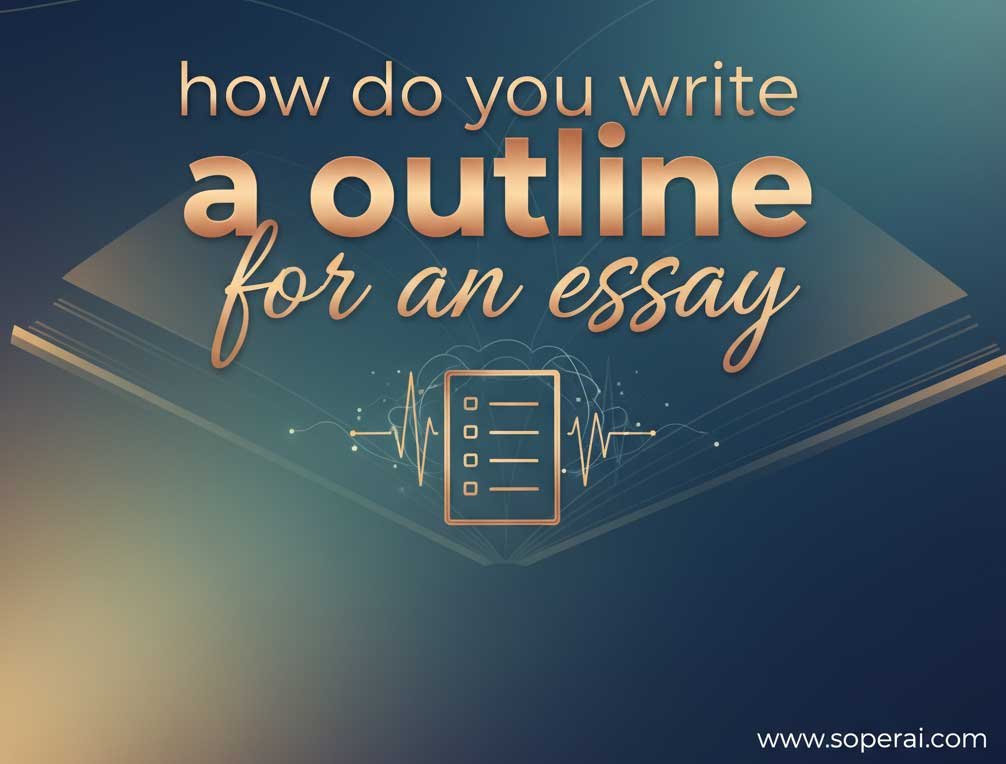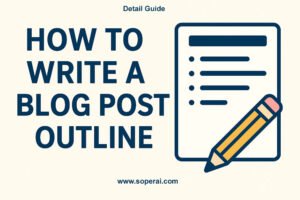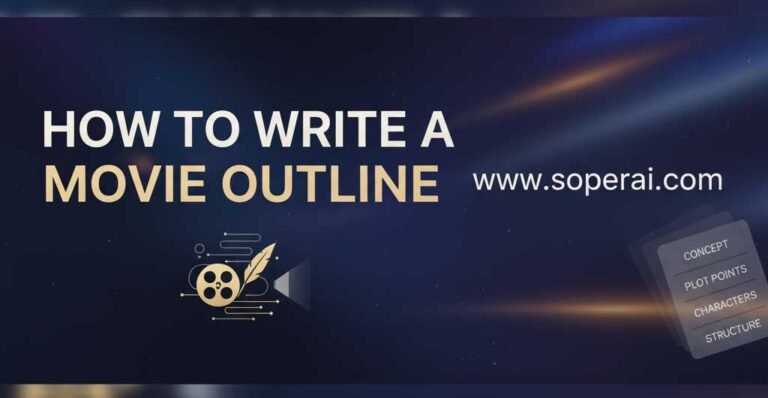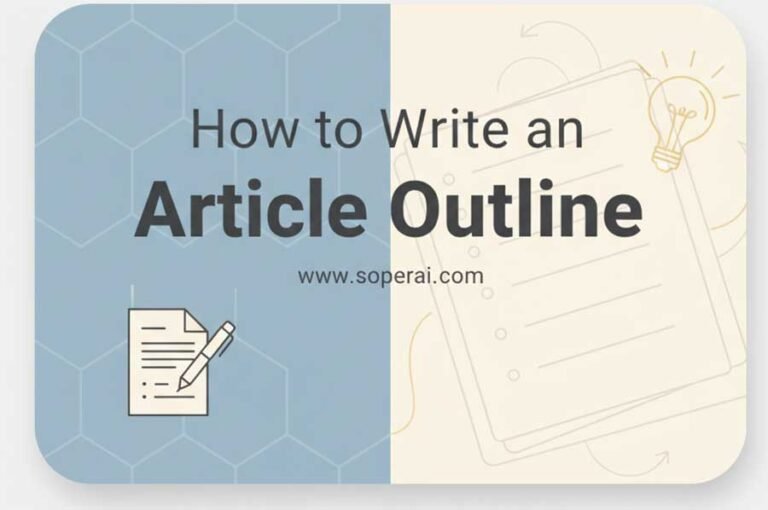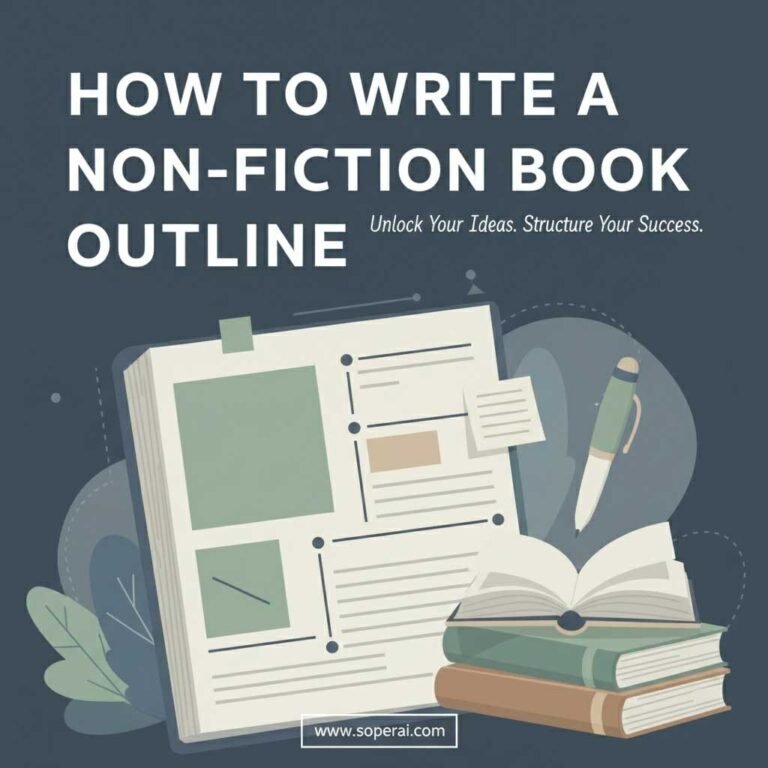How Do You Write an Outline for an Essay? Your Complete Step-by-Step Guide
Picture this: You’re staring at a blank document, the cursor blinking mockingly at you. Your essay is due in three days, and you have a dozen scattered ideas floating around in your head, but no clue how to organize them into something coherent. Sound familiar?
Here’s the thing—most students skip the most crucial step in essay writing: creating an outline. But those who master this skill discover something magical: writing becomes easier, faster, and significantly less stressful.
Whether you’re a high school student tackling your first argumentative essay or a college senior working on your thesis, understanding how do you write an outline for an essay is the secret weapon that separates good writers from great ones. In this comprehensive guide, we’ll walk through everything you need to know about crafting outlines that transform chaotic thoughts into compelling, well-structured essays.
What Is an Essay Outline and Why Does It Matter?
An essay outline is essentially a roadmap for your writing journey. It’s a structured framework that organizes your ideas, arguments, and supporting evidence before you begin the actual writing process. Think of it as the blueprint an architect creates before constructing a building—without it, you’re just hoping everything falls into place.
The beauty of an outline lies in its simplicity. It breaks down your complex essay into manageable sections, showing you exactly what you need to write and in what order. Similar to creating an article outline, an essay outline provides structure and direction to your writing process.
🎯 Organizes Thoughts
Transforms scattered ideas into logical sequences
⏰ Saves Time
Reduces revision time by 50% or more
✍️ Prevents Writer’s Block
Always know what to write next
📝 Ensures Coverage
Never miss key points or arguments
Understanding Your Essay Assignment Before You Outline
Before you even think about creating an outline, you need to thoroughly understand what you’re being asked to write. This might sound obvious, but countless students dive into outlining without fully grasping their assignment requirements—and end up having to start over.
Decoding the Essay Prompt
Read your essay prompt at least three times. On the first read, get the general idea. On the second, highlight key requirements. On the third, identify any subtle nuances or restrictions. Ask yourself these critical questions:
- What type of essay am I writing? (Argumentative, narrative, expository, analytical, compare/contrast)
- What specific question needs to be answered?
- Are there word count or page limits?
- What formatting style is required? (MLA, APA, Chicago)
- Who is my intended audience?
- What is the purpose of this essay?
- Are there any topics or approaches I should avoid?
Pre-Outlining: Research and Brainstorming Essentials
You can’t outline effectively without raw material to work with. The pre-outlining phase is where you gather your ammunition—the ideas, evidence, and insights that will form the foundation of your essay.
Research First, Outline Second
Conduct preliminary research on your topic before attempting to create your outline. You need to understand the landscape of your subject matter. Visit your library’s database, explore academic journals through resources like Google Scholar, and review credible sources related to your topic.
As you research, take notes on:
- Key arguments and counterarguments
- Statistical data and factual evidence
- Expert quotes and scholarly opinions
- Real-world examples and case studies
- Definitions of important terms
Brainstorming Techniques That Actually Work
Once you have your research foundation, it’s time to brainstorm. Different techniques work for different people, so experiment to find what clicks for you:
| Technique | How It Works | Best For |
|---|---|---|
| Mind Mapping | Start with your topic in the center and branch out with related ideas | Visual thinkers who see connections between concepts |
| Free Writing | Write continuously for 10-15 minutes without editing | People who need to overcome perfectionism |
| Listing | Create a simple list of every idea related to your topic | Linear thinkers who prefer organized approaches |
| Clustering | Group related ideas together into themes or categories | Essays with multiple interconnected topics |
| Question Method | Answer who, what, when, where, why, and how about your topic | Research-based and analytical essays |
Crafting Your Thesis Statement
Your thesis statement is the backbone of your entire essay—and consequently, your outline. It’s a single sentence that expresses your main argument or point. A strong thesis is:
- Specific: Avoid vague language; be precise about what you’re arguing
- Arguable: Someone should be able to disagree with it
- Focused: Cover one main idea, not three or four
- Provable: You must be able to support it with evidence
Weak thesis: “Social media is bad for society.”
Strong thesis: “Social media platforms have increased rates of anxiety and depression among teenagers by fostering unrealistic social comparisons and disrupting healthy sleep patterns.”
The Basic Structure of an Essay Outline
Now we’re getting to the heart of how do you write an outline for an essay. Every essay, regardless of type or length, follows a fundamental three-part structure: introduction, body, and conclusion. Let’s break down what goes into each section.
The Essential Three-Part Structure
• Hook to grab attention
• Background information and context
• Clear thesis statement
• Preview of main points
• Topic sentence introducing main point
• Supporting evidence and examples
• Analysis explaining significance
• Smooth transition to next paragraph
• Restatement of thesis (rephrased)
• Summary of key arguments
• Broader implications or final thoughts
• Memorable closing statement
Introduction Section Details
Your introduction outline should include these elements:
- Hook: A compelling opening line (question, statistic, anecdote, or bold statement)
- Context: Background information that helps readers understand your topic
- Thesis: Your main argument stated clearly and concisely
- Roadmap: A brief preview of how you’ll prove your thesis
Body Paragraph Structure
Each body paragraph in your outline should contain:
- Topic Sentence: The main point of this paragraph that supports your thesis
- Evidence: Facts, statistics, quotes, or examples that prove your point
- Analysis: Your explanation of why this evidence matters
- Connection: How this point relates back to your thesis
- Transition: A bridge to your next paragraph
Most essays need between three and five body paragraphs. Any fewer and you’re not developing your argument adequately; any more and you risk losing your reader’s attention or exceeding your word count.
Conclusion Section Components
Your conclusion outline should map out:
- Thesis Restatement: Your main argument phrased in new words
- Summary: Brief recap of your strongest supporting points
- Significance: Why your argument matters in a broader context
- Final Thought: A memorable closing that leaves an impression
Step-by-Step Guide: How Do You Write an Outline for an Essay?
Let’s walk through the actual process of creating your outline, step by methodical step.
Step 1: Choose Your Outline Format
There are three main outline formats to choose from. Each has its strengths, and your choice depends on your personal preference and the complexity of your essay.
Alphanumeric Outline
Uses Roman numerals, capital letters, Arabic numerals, and lowercase letters to organize ideas hierarchically.
A. Hook
B. Background
1. Historical context
2. Current situation
C. Thesis statement
- Best for: Traditional academic essays
- Pros: Clear hierarchy, widely recognized
- Cons: Can feel rigid for creative projects
Decimal Outline
Uses a decimal numbering system to show relationships between points.
1.1 Hook
1.2 Background
1.2.1 Historical context
1.2.2 Current situation
1.3 Thesis statement
- Best for: Technical or scientific papers
- Pros: Shows precise relationships
- Cons: Can become complex quickly
Full Sentence Outline
Each point is written as a complete sentence rather than a phrase.
readers with the topic.
A. The hook will present a
surprising statistic.
B. Background information
will provide context.
- Best for: Complex arguments, group projects
- Pros: Forces clarity, easier to share
- Cons: More time-consuming to create
For most academic essays, the alphanumeric format is your safest bet. It’s what professors expect, and it provides a clear visual hierarchy without being overly complex.
Step 2: Write Your Thesis Statement
We touched on this earlier, but it bears repeating: your thesis must be in place before you can effectively outline. Take time to refine it. Write multiple versions. Show it to classmates or your instructor. A weak thesis will result in a weak outline, which inevitably leads to a weak essay.
Thesis Statement Checklist
✓ Does it take a clear position?
✓ Is it specific enough to be provable?
✓ Can someone reasonably disagree with it?
✓ Does it address the assignment prompt?
✓ Is it a single, focused idea?
Step 3: Identify Your Main Points
Look at your brainstorming notes and research. What are the 3-5 strongest arguments or ideas that support your thesis? These become your body paragraphs. Just like writing a non-fiction book outline, you need to organize your main ideas in a logical sequence.
Consider the order carefully. You have several options:
- Chronological: Present events in time order (good for historical or narrative essays)
- Least to Most Important: Build toward your strongest argument (creates momentum)
- Most to Least Important: Lead with your best point (grabs attention immediately)
- Problem-Solution: Present a problem, then offer solutions (effective for persuasive essays)
- Compare-Contrast: Discuss similarities, then differences, or vice versa
Step 4: Add Supporting Details
Now flesh out each main point with supporting details. Under each body paragraph heading, add:
- Specific evidence (statistics, quotes, data)
- Examples and illustrations
- Expert testimony or scholarly opinions
- Personal anecdotes (if appropriate for your essay type)
- Explanations of how each piece of evidence supports your point
Be sure to note where you found each piece of evidence so you can properly cite it later. Nothing’s worse than having a perfect quote and not remembering which source it came from.
Step 5: Plan Your Introduction and Conclusion
Many writers leave these for last when creating an outline, and that’s perfectly fine. Now that you know what your body paragraphs will say, you can craft an introduction that effectively sets them up and a conclusion that ties everything together.
For your introduction, decide on:
- What type of hook will grab your audience
- What background information is essential (not just interesting)
- How you’ll word your thesis for maximum impact
For your conclusion, plan:
- A fresh way to restate your thesis
- Which main points to emphasize in your summary
- What broader implications or call to action you’ll include
- A memorable final sentence that resonates
Step 6: Review and Refine Your Outline
Don’t just create your outline and move on. Review it critically:
- Check logical flow: Does each point lead naturally to the next?
- Verify thesis support: Does every body paragraph clearly support your thesis?
- Assess balance: Are some sections too detailed while others are sparse?
- Look for gaps: Are there obvious counterarguments you haven’t addressed?
- Test coherence: If someone else read your outline, would they understand your argument?
Tips for Creating Effective Outlines
After years of writing and teaching essay writing, I’ve discovered several strategies that consistently produce better outlines—and therefore better essays.
Organization Tips
Use parallel structure throughout. If your first main point starts with a verb, make sure all your main points start with verbs. This consistency makes your outline clearer and your final essay more readable.
Maintain consistent formatting. Don’t switch between full sentences and phrases randomly. Pick a style and stick with it. This discipline in your outline translates to discipline in your writing.
Keep similar ideas together. Group related concepts within the same section. If you find yourself jumping back and forth between topics, restructure your outline.
Use clear, descriptive headings. Instead of “Body Paragraph 1,” write “Body Paragraph 1: Economic Impacts of Climate Change.” This makes your outline more useful when you’re actually writing.
Content Tips
Be specific but concise. Your outline shouldn’t be your essay in disguise, but it should contain enough detail that you know exactly what you’ll write. Find the balance between “too vague to be useful” and “so detailed it’s redundant.”
Note transitions between sections. Add a quick note about how you’ll bridge from one paragraph to the next. These transition ideas are easy to forget if you don’t write them down.
Mark areas needing more research. If you’re outlining and realize you need more evidence for a particular point, mark it clearly. Don’t wait until you’re drafting to discover these gaps.
Time-Saving Tips
Use outlining software or tools. Google Docs has built-in outline features. Microsoft Word offers outline view. Apps like Scrivener provide sophisticated outlining capabilities. These tools make it easy to reorganize sections by dragging and dropping.
Create templates for recurring essay types. If you write compare/contrast essays frequently, save a blank outline template. The same goes for argumentative essays, literary analyses, or any other common format you encounter.
Build a flexible outline. Don’t view your outline as set in stone. It’s a working document that should evolve as you write. New ideas will emerge during drafting, and that’s not just okay—it’s expected.
Common Outlining Mistakes to Avoid
Even experienced writers fall into these outlining traps. Awareness is the first step to avoiding them.
❌ Creating an Outline That’s Too Vague
An outline that just says “Introduction,” “Body,” “Conclusion” with no details is essentially useless. You need enough specificity to guide your writing. If your outline doesn’t help you know what to write next, it’s too vague.
❌ Making It Too Detailed
On the flip side, if you’re writing complete paragraphs in your outline, you’ve gone too far. You’re essentially writing your essay twice, which defeats the purpose of outlining. Keep it concise—bullet points and brief phrases are your friends.
❌ Failing to Connect Points to the Thesis
Every single body paragraph must support your thesis statement. If you find a point in your outline that seems interesting but doesn’t clearly connect to your main argument, either revise it so it does connect or cut it entirely. Tangential information, no matter how fascinating, weakens your essay.
❌ Ignoring Logical Flow and Transitions
Your outline should show a clear progression of ideas. Each point should build on the previous one. If you’re jumping randomly between topics, your final essay will feel disjointed and confusing.
❌ Skipping the Outlining Process Entirely
The biggest mistake? Not outlining at all. Yes, it takes time upfront, but it saves exponentially more time during writing and revision. Students who skip outlining spend hours staring at blank pages, writing themselves into corners, and doing major rewrites.
❌ Treating Your Outline as Unchangeable
Your outline is a guide, not a prison. If you discover a better way to organize your ideas while drafting, adjust your outline accordingly. Flexibility is a strength, not a weakness.
Outlining for Different Essay Types
Different essay types require different outlining approaches. Let’s explore how to adapt your outline based on what you’re writing.
Argumentative Essays
Argumentative essays need outlines that clearly establish your position, present evidence, address counterarguments, and provide rebuttals. Your outline should include:
- Clear claim: Your thesis should be your main argument
- Supporting evidence: Each body paragraph presents proof of your claim
- Counterarguments: Dedicate at least one paragraph to opposing viewpoints
- Rebuttals: Explain why counterarguments are flawed or less compelling
- Call to action: Your conclusion should motivate readers toward a specific action
I. Introduction
A. Hook: Startling statistic about college debt
B. Background: Rising costs of higher education
C. Thesis: Public universities should be tuition-free for all students
II. Economic Benefits (Body 1)
A. Increased workforce education
B. Higher tax revenue from graduates
C. Evidence from countries with free education
III. Social Equity Arguments (Body 2)
A. Current system favors wealthy students
B. Talent being wasted due to financial barriers
C. Statistics on low-income student college attendance
IV. Counterargument: Cost Concerns (Body 3)
A. Acknowledge high price tag
B. Present funding solutions
C. Compare to other government spending
V. Conclusion
A. Restate thesis with new wording
B. Summarize key benefits
C. Call for policy reform
Narrative Essays
Narrative essays tell a story, so your outline should follow either chronological order or use flashbacks strategically. Similar to writing a fiction book outline, you need to consider story structure, character development, and plot progression.
- Story arc: Include exposition, rising action, climax, falling action, and resolution
- Character development: Note how the narrator changes throughout the story
- Sensory details: Mark where you’ll include vivid descriptions
- Dialogue: Plan key conversations that advance the story
- Theme: Identify the deeper meaning or lesson
Expository Essays
Expository essays explain or inform, requiring clear organization and logical progression. Your outline should emphasize:
- Clear definitions: Define key terms early
- Logical categories: Organize information into meaningful groups
- Step-by-step explanations: Break complex processes into stages
- Factual evidence: Support claims with verifiable information
- Neutral tone: Avoid persuasive language; stick to facts
Compare and Contrast Essays
These essays examine similarities and differences between two or more subjects. You have two main outlining options:
| Point-by-Point Method | Block Method |
|---|---|
| Discuss one aspect of both subjects, then move to the next aspect | Discuss all aspects of Subject A, then all aspects of Subject B |
| Example: I. Cost of Subject A vs. Subject B II. Quality of Subject A vs. Subject B III. Availability of Subject A vs. Subject B |
Example: I. All about Subject A A. Cost B. Quality C. Availability II. All about Subject B A. Cost B. Quality C. Availability |
| Best for: Short essays, closely related subjects | Best for: Longer essays, distinct subjects |
Tools and Resources for Outlining
You don’t need fancy tools to create a great outline—pen and paper work perfectly fine. But if you’re interested in digital solutions, here are some excellent options:
Digital Writing Tools
- Google Docs: Free, collaborative, automatically saves, includes outline feature in document structure
- Microsoft Word: Outline view is robust and easy to use, integrates with your writing
- Scrivener: Professional writing software with advanced outlining capabilities, excellent for longer projects
- Notion: Flexible workspace that allows for various outline formats and easy reorganization
- Evernote: Note-taking app that works well for collecting research and creating outlines
Mind Mapping Software
If you’re a visual thinker, mind mapping tools can help you brainstorm before creating your formal outline:
- MindMeister: Collaborative mind mapping with clean interface
- Coggle: Simple, free tool for creating visual idea maps
- XMind: Professional-grade mind mapping with templates
- SimpleMind: Intuitive interface, works across devices
Reference Management Tools
When outlining research-heavy essays, these tools help organize your sources:
- Zotero: Free, open-source reference manager
- Mendeley: PDF management and citation tool
- EasyBib: Quick citation generation for various formats
You can explore more outlining resources at Purdue OWL’s Developing an Outline guide, which provides additional examples and templates.
Transitioning from Outline to Draft
You’ve created a solid outline. Now what? The transition from outline to draft is where many writers stumble, but it doesn’t have to be difficult.
Using Your Outline as a Roadmap
Think of your outline as GPS directions for your writing journey. You know where you’re starting, where you’re going, and the main points along the way. Your job now is to drive the route, adding details, transitions, and polish as you go.
Start with whichever section feels easiest. There’s no rule saying you must write your introduction first. Many professional writers draft their body paragraphs first, then write the introduction and conclusion once they fully understand their argument.
Expanding Bullet Points into Paragraphs
Take each bullet point in your outline and expand it into full sentences. Add examples, elaborate on your reasoning, and include transitions. Your outline gives you the skeleton; now you’re adding the muscles and skin.
For instance, if your outline says:
A. Constant comparison to others
B. Study from Journal of Social Psychology
C. Personal testimony from interviews
Your paragraph might expand to:
Maintaining Flexibility During Writing
Your outline is a guide, not a contract. As you write, you’ll discover new ideas, better ways to phrase arguments, or realize that certain points don’t work as well as you thought. That’s completely normal and actually a sign of good critical thinking.
If you need to deviate from your outline:
- Make sure the new direction still supports your thesis
- Update your outline to reflect the changes
- Check that your essay still flows logically
- Ensure you haven’t created gaps or redundancies
Keeping Your Thesis in Focus
As you draft, constantly return to your thesis. After finishing each paragraph, ask yourself: “Does this clearly support my main argument?” If the connection isn’t obvious, either revise the paragraph to make it clearer or consider whether it belongs in your essay at all.
Print your thesis statement and keep it visible while you write. This simple trick helps prevent the common problem of drifting off topic halfway through your essay.
Practice Exercise: Creating Your Own Essay Outline
Let’s put everything together with a practical exercise. I’ll provide a sample essay prompt, then walk you through creating an outline for it.
Step 1: Analyze the Prompt
- Essay type: Argumentative
- Topic: Carbon tax policy
- Position required: For or against
- Word count: 1,500-2,000 words
- Requirements: Evidence-based, must address counterargument
Step 2: Develop Your Thesis
“Implementing a carbon tax is essential for reducing greenhouse gas emissions and should be adopted nationwide, with revenue redirected to renewable energy development and assistance for affected workers.”
Step 3: Create the Full Outline
I. Introduction
A. Hook: Statistic about record-breaking temperatures in recent years
B. Background: Explain what a carbon tax is and how it works
C. Context: Brief overview of current climate policies
D. Thesis: Implementing a carbon tax is essential for reducing greenhouse
gas emissions and should be adopted nationwide, with revenue redirected
to renewable energy development and assistance for affected workers
II. Carbon Taxes Effectively Reduce Emissions (Body Paragraph 1)
A. Topic sentence: Evidence shows carbon taxes work
B. British Columbia case study – 5-15% reduction in emissions
C. Sweden’s success story – emissions down 25% since 1995
D. Economic principle: pricing externalities changes behavior
E. Transition: Beyond environmental benefits, economic advantages exist
III. Economic Benefits Outweigh Costs (Body Paragraph 2)
A. Topic sentence: Carbon tax stimulates green economy
B. Revenue generation statistics
C. Job creation in renewable energy sector
D. Innovation incentives for clean technology
E. Transition: However, critics raise valid concerns
IV. Counterargument: Economic Harm to Workers and Consumers (Body Paragraph 3)
A. Topic sentence: Acknowledge concerns about economic impact
B. Present opposition argument – job losses in fossil fuel industries
C. Concern about increased energy costs for consumers
D. Rebuttal: Revenue can fund transition programs
E. Example of “just transition” policies from other countries
F. Transition: Long-term costs of inaction far exceed short-term adjustment costs
V. The Cost of Inaction Is Greater (Body Paragraph 4)
A. Topic sentence: Delaying action increases future costs
B. Climate disaster economic impact projections
C. Health costs from air pollution
D. Infrastructure damage from extreme weather
E. Citation from IPCC reports on urgency
VI. Conclusion
A. Restate thesis: Carbon tax is necessary and feasible policy
B. Summarize main points:
1. Proven emission reductions
2. Economic opportunities
3. Concerns are addressable
C. Broader implication: Climate action requires bold policy moves
D. Call to action: Urge readers to contact representatives
E. Closing statement: Future generations depend on action today
Notice how this outline follows all the principles we discussed. It has a clear structure, each body paragraph supports the thesis, counterarguments are addressed, and transitions are noted. This outline would make writing the actual essay much more straightforward.
Advanced Outlining Techniques
Once you’re comfortable with basic outlining, these advanced techniques can take your outlines to the next level.
Color-Coding Your Outline
Use different colors to represent different types of content:
- Blue: Main arguments and topic sentences
- Green: Evidence and supporting data
- Yellow: Areas needing more research
- Red: Counterarguments and rebuttals
- Purple: Transitions and connections
This visual system helps you quickly identify whether your outline is balanced and where you might need to add more support.
The Reverse Outline Technique
If you’ve already written a rough draft without an outline (we’ve all been there), create a reverse outline by reading your draft and noting the main point of each paragraph. This reveals structural problems, repetitive content, or missing logical connections that you can fix in revision.
Collaborative Outlining
For group projects, collaborative outlining ensures everyone understands the essay’s direction before drafting begins. Use Google Docs or similar platforms where team members can add comments, suggest changes, and see updates in real time. Much like writing a movie outline for a film project, collaborative essay outlines benefit from multiple perspectives.
Troubleshooting Common Outline Problems
Even experienced writers encounter outline challenges. Here’s how to solve the most common problems.
Problem: Your Outline Feels Unbalanced
Solution: Check the number of sub-points under each main point. If one body paragraph has seven pieces of evidence while another has only one, you need to either find more support for the weak section or cut some content from the heavy section.
Problem: You Can’t Find Enough Support for a Point
Solution: If you’re struggling to find evidence for one of your main points, it might be a weak argument. Consider replacing it with a stronger point or combining it with another related idea.
Problem: Everything Seems Equally Important
Solution: Force yourself to rank your points from strongest to weakest. If you truly can’t decide, ask a friend or classmate to review your outline and give their opinion on which arguments are most convincing.
Problem: Your Outline Is Too Long
Solution: Remember that your outline should be significantly shorter than your final essay. If your outline is approaching 50% of your target word count, you’re including too much detail. Condense phrases, eliminate redundancy, and trust that you’ll expand appropriately during drafting.
Ready to Master Essay Outlining?
The difference between a mediocre essay and an excellent one often comes down to the quality of the outline. Take the time to plan your structure, organize your thoughts, and create a roadmap for your writing. Your future self—the one actually writing the essay—will thank you profusely.
Final Thoughts on Essay Outlines
Learning how do you write an outline for an essay is one of the most valuable skills you can develop as a writer. It transforms the overwhelming task of writing from a chaotic struggle into a manageable process. Your outline becomes your safety net, your guide, and your accountability partner all rolled into one.
The students who consistently produce high-quality essays aren’t necessarily the ones with the largest vocabularies or the most natural writing talent. They’re the ones who understand that good writing is built on good planning. They’re the ones who invest time in outlining because they know it pays enormous dividends during the drafting and revision stages.
Remember these key takeaways:
- Always start with a clear understanding of your assignment
- Conduct research and brainstorming before outlining
- Choose an outline format that works for your essay type
- Ensure every point supports your thesis statement
- Include enough detail to guide your writing without becoming the essay itself
- Review and refine your outline before you start drafting
- Stay flexible—your outline can evolve as you write
- Use your outline as a roadmap, not a prison
Different writing projects require different approaches to outlining. While this guide focuses on essays, the fundamental principles apply broadly. Whether you’re creating article outlines for blog posts, non-fiction book outlines for larger projects, or even fiction outlines for creative writing, the core concepts remain the same: organization, structure, and logical flow.
The beauty of outlining is that it gets easier with practice. Your first few outlines might feel awkward and time-consuming. You might wonder if it’s really worth the effort. But stick with it. By your fifth or sixth essay, you’ll find yourself creating comprehensive outlines in a fraction of the time. By your tenth, outlining will feel as natural as breathing.
And here’s a secret that experienced writers know: the better you get at outlining, the better your first drafts become. You’ll find yourself spending less time revising, fewer moments of staring blankly at your screen, and more confidence in your writing. Your essays will have better flow, stronger arguments, and clearer organization—all because you took the time to plan before you wrote.
So the next time you’re assigned an essay, resist the urge to dive straight into writing. Open a new document, start with your thesis, and build your outline piece by piece. Trust the process. Your outline is the foundation upon which your entire essay will stand, and a solid foundation makes everything that follows stronger and more stable.
Start Outlining Your Next Essay Today
Don’t wait for the perfect moment or the perfect idea. Take your current essay assignment, grab your favorite outlining tool (even if it’s just pen and paper), and start structuring your thoughts. Remember, a mediocre outline is infinitely better than no outline at all. You can always refine and improve it—but only if you create one in the first place.
Your journey to becoming a more confident, efficient, and effective writer starts with a single outline. Make today the day you commit to this essential writing skill. Your grades, your stress levels, and your future as a writer will all improve dramatically.
Happy outlining, and even happier writing!
FAQS
1. What exactly is an essay outline and why do I need one?
An essay outline is a structured plan that organizes your main ideas, arguments, and supporting evidence before you begin writing. It serves as a roadmap for your essay, showing the logical flow from introduction to conclusion. You need an outline because it saves time, prevents writer’s block, ensures your arguments stay focused and coherent, and helps you identify gaps in your research or logic before you’ve invested hours in writing. Think of it as the blueprint for building your essay—it’s much easier to make changes to the plan than to rebuild the entire structure later.
2. How detailed should my essay outline be?
The ideal level of detail depends on your personal preference and the complexity of your essay. A good rule of thumb is to include enough detail that you could step away for a week and still understand your plan when you return. Typically, this means including your thesis statement, main topic sentences for each paragraph, key supporting evidence or examples, and brief notes about how ideas connect. Avoid making your outline so detailed that you’re essentially writing the entire essay—bullet points and short phrases work better than full sentences for most sections.
3. What’s the difference between alphanumeric and decimal outline formats?
An alphanumeric outline uses a combination of Roman numerals, capital letters, Arabic numbers, and lowercase letters to indicate hierarchy (I, A, 1, a). A decimal outline uses only numbers with increasing decimal points to show relationships (1.0, 1.1, 1.1.1, 1.1.2). Both formats work equally well—alphanumeric is more traditional and widely recognized, while decimal outlines can make the hierarchy clearer for complex topics with many levels. Choose whichever format feels more intuitive to you and is accepted by your instructor.
4. Should I write my thesis statement before or after creating the outline?
Ideally, you should develop a working thesis statement before creating your detailed outline. Your thesis acts as the foundation for your entire essay, and every point in your outline should support or relate to it. However, it’s normal for your thesis to evolve as you outline and research. Start with a preliminary thesis to guide your outline, then refine it as your ideas become clearer. Many writers go back and forth between their thesis and outline several times before settling on the final version.
5. How many main points should I include in my essay outline?
For most standard essays, 3-5 main points work best. This provides enough substance to thoroughly explore your topic without overwhelming your reader or making your essay too lengthy. Each main point should become one body paragraph (or a group of related paragraphs for longer essays). The specific number depends on your essay length, topic complexity, and assignment requirements. A 5-paragraph essay typically has 3 main points, while a 10-page research paper might have 5-7 major sections.
6. Can I change my outline after I start writing the essay?
Absolutely! An outline is a flexible tool, not a rigid contract. As you write, you may discover better ways to organize your ideas, find new evidence that changes your argument, or realize certain points don’t work as well as you thought. It’s perfectly normal—and often beneficial—to revise your outline during the writing process. The outline exists to serve your writing, not restrict it. Just ensure any changes still support your thesis and maintain logical flow.
7. What’s the best way to organize the body paragraphs in my outline?
The organization depends on your essay type and argument. Common organizational patterns include: chronological order (for narratives or historical analysis), order of importance (strongest argument first or last), cause and effect, problem and solution, or compare and contrast. For argumentative essays, consider arranging from weakest to strongest point to build momentum, or strongest first to grab attention immediately. Whatever order you choose, ensure smooth transitions between points and that each paragraph logically leads to the next.
8. Do I need to include my introduction and conclusion in the outline?
Yes, you should outline both your introduction and conclusion, though they can be briefer than body paragraph sections. For the introduction, note your hook strategy, background information to include, and your thesis statement. For the conclusion, plan how you’ll restate your thesis, summarize main points without repeating verbatim, and what final thought or call to action you’ll leave readers with. Having these sections outlined ensures your essay has a strong opening and satisfying closure.
9. What tools or software can help me create an outline?
Many options exist for creating outlines. Simple tools include Microsoft Word’s outline view, Google Docs with heading styles, or even plain text editors. For more features, try dedicated outlining software like Scrivener, Workflowy, or Dynalist. Mind mapping tools like MindMeister, Coggle, or XMind can help visualize connections between ideas. Many students also prefer traditional pen and paper for the brainstorming phase. Choose whatever tool helps you think most clearly—the format matters less than the thinking process.
10. How long should it take to create an essay outline?
Creating a solid outline typically takes 20-45 minutes for a standard essay, though this varies based on topic complexity and familiarity. If you’re writing about something you know well, outlining might take 15-20 minutes. For research papers on unfamiliar topics, you might spend an hour or more on research and outlining combined. While it might seem like time you could spend writing, remember that a good outline actually saves time overall by preventing false starts, reducing rewrites, and keeping you focused while drafting.

